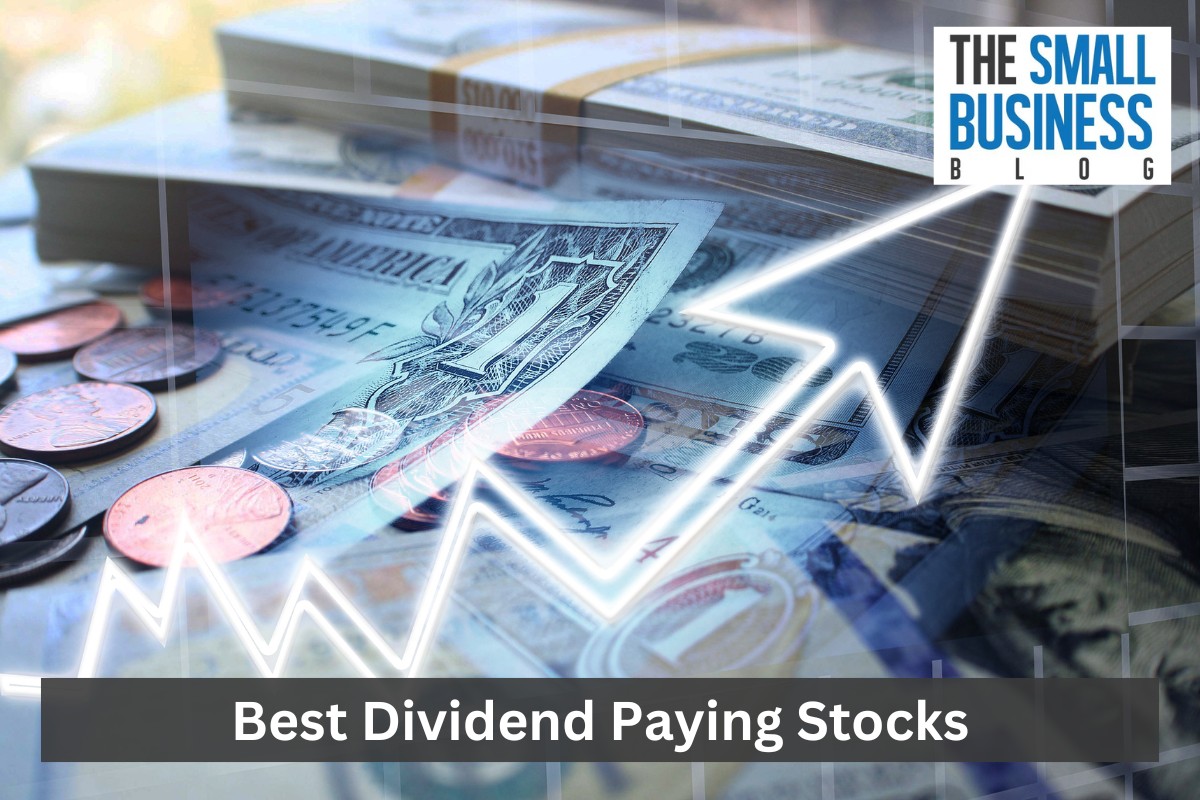If you want to invest in stocks and earn a steady income stream, dividend-paying stocks can be an excellent choice.
These stocks have the potential for capital appreciation and provide you with regular dividends, offering a unique blend of growth and stability.
In this article, we will delve into the world of dividends and introduce you to the 11 best dividend paying stocks you should consider adding to your investment portfolio.
Post Contents
- 1 Best Dividend Paying Stocks to Buy Now
- 1.1 1. Abbott Laboratories (ABT)
- 1.2 2. Altria Group (MO)
- 1.3 3. American Tower Corporation (AMT)
- 1.4 4. Chevron Corporation (CVX)
- 1.5 5. Coca-Cola Company (KO)
- 1.6 6. Ecolab Inc. (ECL)
- 1.7 7. Johnson & Johnson (JNJ)
- 1.8 8. Mastercard Incorporated (MA)
- 1.9 9. Microsoft Corporation (MSFT)
- 1.10 10. Procter & Gamble Company (PG)
- 1.11 11. Walmart Inc. (WMT)
- 2 Considerations for Choosing Dividend Stocks
- 3 Practical Strategies for Successful Dividend Investing
- 4 Frequently Asked Questions
- 5 Conclusion
Best Dividend Paying Stocks to Buy Now

1. Abbott Laboratories (ABT)
Abbott Laboratories (ABT) is a pharmaceutical and medical device company that develops, manufactures, and sells medical devices, diagnostics, and pharmaceuticals.
The company has a long history of dividend growth, having increased its dividend for 51 years in a row.
Abbott is a Dividend Aristocrat, having been a member of the S&P 500 Index for the past 25 years.
This index includes companies that have increased their dividend payout for at least 25 years.
2. Altria Group (MO)
Altria Group (MO) has charted an impressive path in the tobacco industry, maintaining dividends since 1985.
MO’s tenacity shines through industry changes, and its debt-to-equity ratio 0.6 is commendable.
The company’s ability to adapt and thrive demonstrates its value as a Dividend Aristocrat.
While the tobacco landscape shifts, MO’s dividends remain consistent, indicating that consistent returns are possible even in volatile markets.
3. American Tower Corporation (AMT)
With 19 consecutive years of dividend growth, American Tower Corporation (AMT), a real estate investment trust, has reached new heights.
The development of wireless communication has propelled AMT’s towers to prominence, resulting in consistent returns.
Its status as a Dividend Aristocrat adds to its allure.
AMT’s dividends rise alongside its towers, cementing its reputation as an investor income generator.
4. Chevron Corporation (CVX)
Chevron Corporation (CVX), a global oil and gas conglomerate, powers the world and investor portfolios.
CVX demonstrates resilience in energy markets and dividend distribution, with a 33-year streak of dividend increases and a debt-to-equity ratio of 0.2.
The ability of the company to navigate economic cycles while providing consistent income exemplifies the value of dividend-paying stocks.
5. Coca-Cola Company (KO)
Since 1893, the Coca-Cola Company (KO), best known for its beverages, has been refreshing portfolios and quenching thirst.
KO exemplifies financial stability with a debt-to-equity ratio of 0.4.
Its long-term dividend payments, which have lasted over a century, demonstrate its dedication to shareholder value.
KO’s dividends are as classic as the beverages it offers.
6. Ecolab Inc. (ECL)
Ecolab Inc. (ECL), which provides environmental services, reflects its commitment to dividend growth.
ECL’s dividends are as dependable as its hygiene solutions, with a 15-year streak of consecutive dividend increases.
As a Dividend Aristocrat, ECL demonstrates its ability to maintain sustainability in both environmental and financial practices.
7. Johnson & Johnson (JNJ)
Johnson & Johnson (JNJ) not only heals but also writes a dividend saga in healthcare.
JNJ demonstrates healthcare and financial strength, with an astonishing 60 years of dividend growth and a debt-to-equity ratio 0.3.
JNJ’s dividends tell a story of stability and resilience, consistent with the company’s mission of improving people’s lives worldwide.
8. Mastercard Incorporated (MA)
Mastercard Incorporated (MA), a financial services leader, processes dividends and payments precisely.
MA demonstrates its ability to consistently deliver value to investors with 13 years of consecutive dividend growth.
MA ensures smooth financial transactions, and its dividends provide a consistent income stream.
9. Microsoft Corporation (MSFT)
Microsoft Corporation (MSFT), a tech behemoth, innovates its dividends similarly to its products.
It bridges the gap between technology and investment stability with a decade of consistent dividend increases.
MSFT’s ability to thrive in volatile tech markets while paying dividends attests to its long-term value.
10. Procter & Gamble Company (PG)
Since 1890, the Procter & Gamble Company (PG), synonymous with household essentials, has been cleansing portfolios.
With a debt-to-equity ratio of 0.3, PG offers cleaning products and a track record of consistent dividend payments.
The ability of PG to adapt to changing consumer needs while consistently rewarding shareholders demonstrates the company’s resilience.
11. Walmart Inc. (WMT)
Walmart Inc. (WMT), a retailing behemoth, elevates its store shelves and investor portfolios.
WMT’s commitment to consistent income is unwavering, with a 44-year streak of consecutive dividend growth.
Its status as a Dividend Aristocrat demonstrates its ability to provide consistent returns similar to everyday necessities.
Considerations for Choosing Dividend Stocks

There are several important factors to consider when choosing dividend-paying stocks:
Yield on Dividends
Dividend yield is an important metric that indicates how much annual dividend income you can expect based on the stock’s price.
It is calculated by dividing the annual dividend by the stock’s current market price.
A higher dividend yield can indicate an appealing investment opportunity, but excessively high yields may be unsustainable.
History of Dividends
A track record of consistent dividend payments is a good sign.
Companies with a history of increasing dividends consistently demonstrate financial stability and a commitment to rewarding shareholders.
Payout Percentage
The payout ratio is the proportion of earnings distributed as dividends.
A reasonable payout ratio is usually required to support a sustainable dividend.
High payout ratios may indicate the company is overextending itself regarding dividend distribution.
The Financial Health of the Company
Before purchasing any stock, evaluating the company’s financial health is critical.
Consider things like revenue growth, profitability, and debt levels.
A financially strong company is better positioned to keep paying dividends.
Practical Strategies for Successful Dividend Investing

When diving into the world of dividend investing, employing practical strategies can significantly enhance your chances of success.
Let’s explore these strategies in greater detail:
Spread Your Investments
Diversification is a cornerstone of successful investing.
Instead of concentrating your investments in a single sector or industry, spread them out.
This approach helps cushion your portfolio against the impact of market volatility.
Owning stocks from various sectors reduces the risk of being heavily affected if one industry faces challenges.
Do Your Homework
Before investing, conduct thorough research on the companies you’re considering.
Look beyond the surface and delve into their financials.
Examine their revenue trends, debt levels, and earnings consistency.
To gauge their commitment to rewarding shareholders, analyze their dividend history.
Companies with a track record of consistent dividends are often more reliable options.
Think Long-Term
Dividend investing flourishes with a long-term perspective.
As you receive dividends, consider reinvesting them by purchasing more shares.
Over time, these additional shares generate their dividends, creating a compounding effect.
This can substantially boost your overall returns, especially when practiced over an extended period.
Understand the Numbers
Beyond the dividend yield, other metrics provide valuable insights.
The dividend payout ratio (dividends divided by earnings) reveals the portion of profits allocated to dividends.
A sustainable ratio indicates the company is not overextending itself to pay dividends.
Additionally, consider the dividend growth rate, which shows how much the dividends have increased over time.
A consistent growth rate reflects the company’s commitment to rewarding shareholders.
Time the Market Wisely
Market volatility can present opportunities for savvy dividend investors.
When markets dip, consider using your dividends to purchase more shares at discounted prices.
This practice, known as dividend reinvestment, allows you to acquire additional shares while prices are lower.
As markets recover, these additional shares can contribute to more significant gains.
Look at Management
A company’s management team plays a critical role in its success.
Research the leaders’ track records, expertise, and alignment with shareholders’ interests.
A capable and transparent management team is more likely to make decisions that support the company’s growth and stability, including consistent dividend payments.
Get Expert Advice
If you’re new to dividend investing or find it complex, seeking advice from financial professionals can be invaluable.
Experienced advisors can offer personalized guidance based on your financial situation, risk tolerance, and goals.
Their expertise can help you make well-informed decisions aligned with your investment objectives.
Frequently Asked Questions
Are dividend payments guaranteed?
Dividend payments are not guaranteed.
They hinge on various factors, primarily the financial performance of the company.
If a company’s earnings are strong, it’s more likely to continue paying dividends.
However, economic downturns or changes in the company’s business landscape can impact its ability to sustain dividend payments.
Board decisions also play a role; if the company’s leadership decides to allocate funds elsewhere or faces unforeseen challenges, dividend payments could be affected.
Can dividend stocks appreciate?
Dividend stocks can appreciate over time.
When a company consistently performs well and generates profits, its stock price tends to rise.
This growth contributes to the capital appreciation of your investment.
On top of that, receiving regular dividends provides you with a consistent income stream.
So, dividend stocks offer the dual benefit of potential capital gains and steady income.
What is a dividend aristocrat?
A dividend aristocrat is a company that has achieved an impressive milestone in its dividend history.
Specifically, a company has consistently increased its dividend payments for many years, usually 25 or more.
These companies exhibit financial stability, disciplined management, and a commitment to rewarding shareholders.
Being a dividend aristocrat signifies a strong track record of paying dividends and consistently raising them, reflecting the company’s resilience and dedication to shareholder value.
Do all companies pay dividends?
No, not all companies choose to pay dividends to their shareholders.
Some companies reinvest their earnings into the business to fuel growth, research, and development.
These companies believe that reinvesting in themselves can lead to even greater value for shareholders in the long run.
On the other hand, dividend-paying companies distribute a portion of their profits to shareholders as dividends, which can be particularly appealing to investors seeking regular income.
How often are dividends usually paid?
Dividend payment frequency can vary, but common patterns include quarterly, monthly, or annually.
Quarterly dividends are the most typical, with companies distributing dividend payments every three months.
Monthly dividends provide more frequent income, while annual dividends are less common and usually offered by companies with a specific financial structure.
Conclusion
You can strike a healthy balance between the potential for income and the potential for capital growth by including in your investment strategy these 11 best dividend paying stocks.
Build a portfolio with these carefully selected well-known businesses for their solid financial footing and consistent dividend track records.
This will not only ensure the stability of your investments but will also pave the way for the gradual accumulation of wealth over the course of time.






























